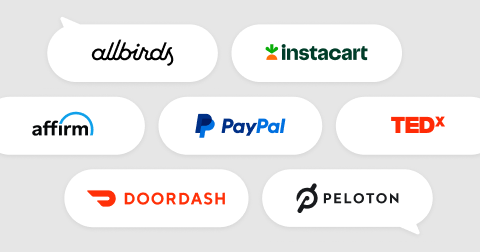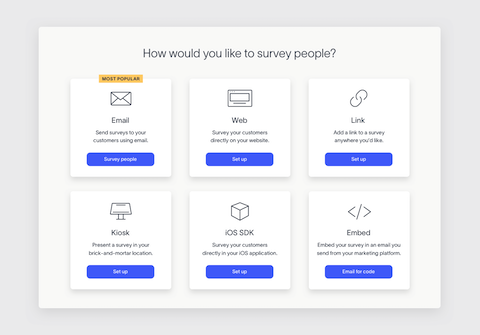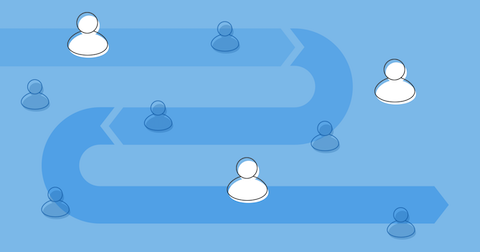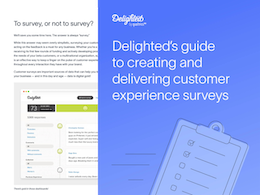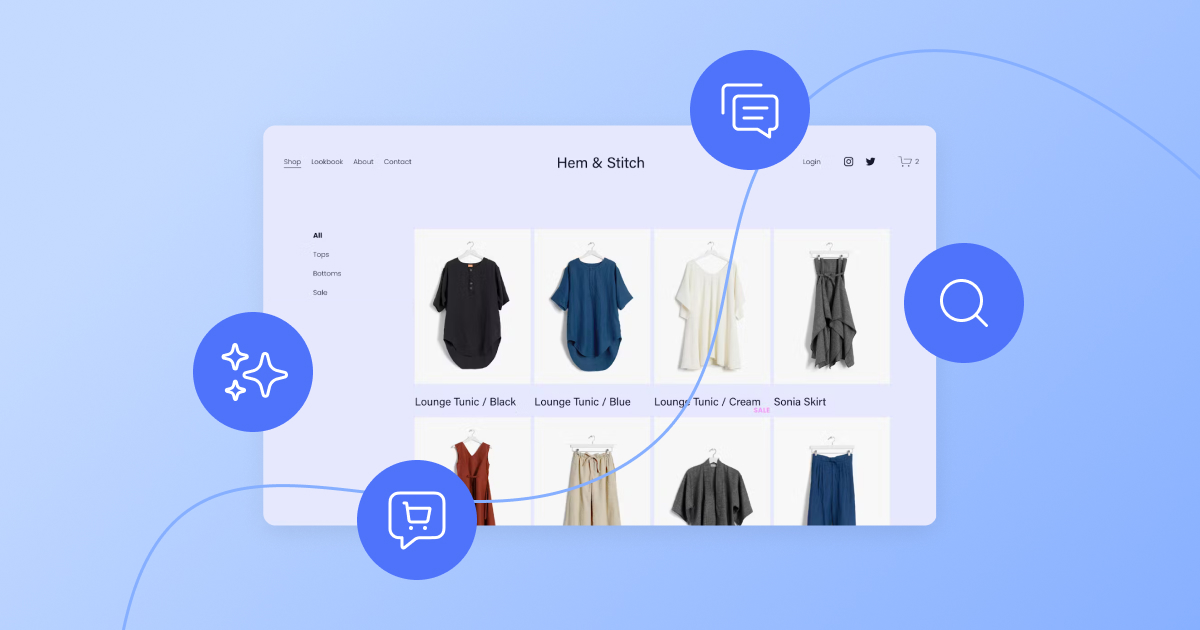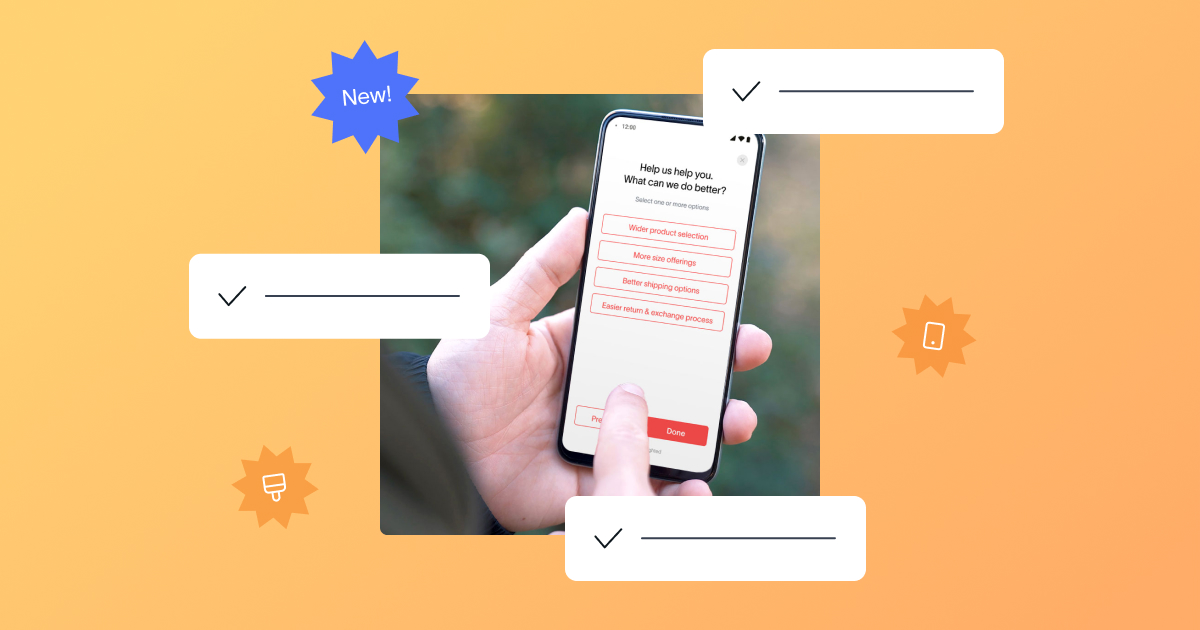Strong customer experience (CX) is a key driver of business success and longevity, especially since 73% of customers point to CX as an important factor in their purchasing decision.
But in order to build a foundation for positive customer experiences, it’s necessary to know popular CX terms and their acronyms — including NPS, VoC, DCX, CSAT, and more.
Understandably, it can be overwhelming. That’s why we’ve put together a customer experience glossary.
The following three sections explore all the terms you’ll need to know to pave the way for your organization’s customer experience strategy:
Core customer experience concepts
First, let’s dive into the most relevant terms to know in the CX space, from customer experience as a whole to CX improvement exercises like customer journey mapping.
What is CX? (CX meaning)
Customer experience, or CX, is the overall perception a customer has of your brand after interacting with your business across the buyer’s journey. From marketing, to sales, to customer service – CX is the sum of all touchpoints and can impact a customer’s decision to return to your brand.
CX isn’t limited to what a customer thinks about your product, the visual elements of your website, or how they interact with your customer service team — it’s all of it. It’s how they feel about their entire experience with your brand, both offline and online.
Digital customer experience (DCX)
Digital customer experience refers to the overall perception of your brand in the eyes of your customer, based on interactions across digital platforms.
The main distinction between digital CX and general CX is the focus on customers’ digital experience with your brand. This is important to highlight because many businesses struggle to keep up with digital transformation (think brick-and-mortar retail versus ecommerce) in their industry and its impact on their customers and internal operations.
Optimizing DCX is paramount when tackling Customer Experience Management as a whole, especially if you want to improve CX at your company.
Customer Experience Management (CEM or CXM)
Customer Experience Management is an inter-departmental effort to understand customer sentiment throughout the entire customer journey, and act on that intelligence to deliver improved experiences.
A company’s ability to continually deliver improved customer experiences has a big impact on the entire sales cycle. It can help you increase sales at the beginning of the customer journey and provide better support to build customer loyalty at the end. In order to deliver great experiences, you’ll need to know what your customers expect from you and your brand.
Customer Experience Management helps you gather and understand customer expectations, anticipate their problems, and proactively find solutions. A key part of managing the customer experience is building out a customer experience program, which we’ll cover next.
Customer experience program
A customer experience program refers to the tools and processes used to implement your customer experience management strategy.
Your CX program should be unique to your organization. It requires you to align your teams on customer centricity and collectively understand who your customers are and how your relationship with them evolves over time.
The goal of a customer experience program is to gather feedback via customer experience surveys, uncover customer insights from that data, and take action to close the loop and improve experiences.
Customer sentiment
Customer sentiment is how customers feel about your business. It could be how they feel about a specific interaction or your brand overall.
There’s an important distinction between understanding how the customer feels and whether they take any action. For instance, a customer could feel frustrated with your checkout process and still purchase your product. However, would they buy from you again, or go to a competitor?
Customer sentiment answers the question, “how are customers feeling when they interact with my company?” so you have additional context around present and future customer behavior.
The key to evaluating customer sentiment is a critical CX measurement: customer satisfaction.
Customer satisfaction
Customer satisfaction is a measurement of how well a company’s products or services meet or miss customer expectations.
Customer satisfaction is at the core of the human-to-brand experience, but is notoriously difficult to measure since it is an emotion.
Companies most commonly turn to metrics such as Customer Satisfaction Score (CSAT) and Customer Effort Score (CES) to accomplish this, relying on customer surveying to collect customer satisfaction feedback and calculate these scores.
Customer delight
Customer delight is a company’s ability to surprise their customers with an experience that goes above and beyond, exceeding expectations.
When expectations are met, you have customer satisfaction. When expectations are exceeded, you achieve customer delight, which is what will truly set you apart from the competition and increase customer loyalty.
Customer loyalty
Customer loyalty is the ongoing, positive relationship established between a business and its customers, characterized by repeat business.
What’s more, your most loyal customers may also tell their family and friends about your company. They are your most valuable customers, as they drive brand advocacy.
Brand advocacy
Brand advocacy is when customers recommend businesses they like across their network, including family, friends, and coworkers.
These customers refer new business through word of mouth because they think others will benefit from a relationship with your company.
Word of mouth significantly impacts customer purchasing decisions, with 88% of people surveyed reporting they had the highest level of trust in a brand when a friend or family member recommended it.
How do you build customer loyalty and turn customers into brand advocates? Start by measuring satisfaction at your most important customer touchpoints with customer journey mapping.
Customer journey map
A customer journey map is a visual representation of the various interactions and touchpoints a customer has with a company.
Because every engagement with your brand is an opportunity for your business to delight (or disappoint) your customers, you want to ensure every customer interaction is the best it can be.
Customer interactions are singular, unique points in time when a customer engages with your brand. What a customer journey map does is plot out each of these interactions as a touchpoint.
These touchpoints may or may not involve human-to-human interaction. Whether customers are adding their favorite items to their digital shopping cart or making a purchase in-person, every interaction can be an opportunity to build a more personal relationship.
Customer journey maps are vital to understanding different interactions as customers come into contact with your company, product, marketing messaging, and/or employee through any channel or device.
Determining the positive (or detrimental) effect of any changes made to customer touchpoints requires you to start evaluating and measuring customer experiences.
Measuring the customer experience
What differentiates good customer experience from great customer experience is measuring your progress. Track the following CX metrics to quantify whether or not you’re successfully creating positive customer experiences.
Customer intelligence
Customer intelligence is the collection and analysis of customer data for a holistic understanding of your customers that evolves with them over time.
With customer intelligence, you’ll not only understand the “who, what, when, and where” of customer behavior, but you’ll also understand the “why.” Understanding why customers behave the way they do can help you make strong business decisions and best practices to ensure your company’s longevity.
Customer intelligence can be broken down into two categories: quantitative data from customer analytics, and qualitative data from customer feedback.
Let’s start with customer analytics.
Customer analytics
Customer analytics is the tracking and visualization of customer behavior data, measured in numerical values or counts, in order to uncover insights that help inform better business decisions.
The data collected in customer analytics is quantitative data — or numerical data. Here are examples of a few important quantitative customer analytics metrics to know:
- Customer churn or churn rate: The rate at which customers or subscribers stop doing business with a company or service.
- Customer retention or retention rate: The percentage of customers that remain customers over a given time period.
- Customer lifetime value (CLV): The measurement of a customer’s total revenue value to a company over the lifespan of the relationship.
Customer analytics can serve as a great starting point for checking the pulse on your overall customer experience, but don’t stop there. Collecting written feedback directly from your customers is integral to uncovering key insights to improve customer experiences.
Voice of the customer (VoC)
Voice of the Customer (VoC) is a methodology used to collect written or spoken feedback from customers, whether directly provided through customer surveys and focus groups, or indirectly acquired from monitoring customer word of mouth on channels such as social media, forums, and review sites.
The data collected in Voice of the Customer efforts is qualitative data — written or spoken word. The most impactful customer feedback comes directly from the customers. Customer experience survey methodologies such as Net Promoter Score (NPS), Customer Satisfaction Score (CSAT), and Customer Effort Score (CES) help you gather more direct customer feedback.
Beyond the qualitative feedback provided, these survey methods provide quantitative scores that help your organization benchmark and improve experiences over time.
Net Promoter Score (NPS)
Net Promoter Score or Net Promoter System (NPS) is a customer experience survey methodology and metric used to measure customer loyalty through first-hand feedback.
The methodology starts with asking a single question: “How likely are you to recommend [company/product] to a friend or colleague?” Customers answer on a scale of 0-10 (not likely to very likely).

The second half of the NPS survey is a free-form follow-up question that allows customers to provide valuable detail on their previous answer.
Customers are then segmented into three groups according to their numerical response to the 0-10 rating question: promoters (score 9-10), passives (score 7-8), and then detractors (score 0-6).
Subtracting the percentage of detractors from the percentage of promoters yields the Net Promoter Score. The score can range from as low as -100 (if every customer is a detractor and would not recommend your business) to a high of 100 (if every customer is a promoter and is likely to refer your company).
Customer Satisfaction Score (CSAT)
Customer Satisfaction Score is a customer experience survey methodology and metric that measures customer satisfaction with your product or service.
This methodology evolved from market research surveys, and it’s easy to understand, simple to use, and rich in insight.
By asking your customers to rate on a scale of 1-5 how they feel about the goods/services received, you get a trackable score that maps to how satisfied your customers are.
TIP: Learn the answer to “what is CSAT?” and more in our guide.

Customer Effort Score (CES)
Customer Effort Score is a customer experience survey methodology and metric used to measure the effort a customer makes when interacting with your company (e.g., getting a question resolved or purchasing a product).
The theory of this methodology is the lower the effort, the happier the customer. CES asks questions like, “How easy was it to resolve your issue?” and is typically measured the same way as CSAT, with a single-question survey using a 1-5 or 1-7 scale.
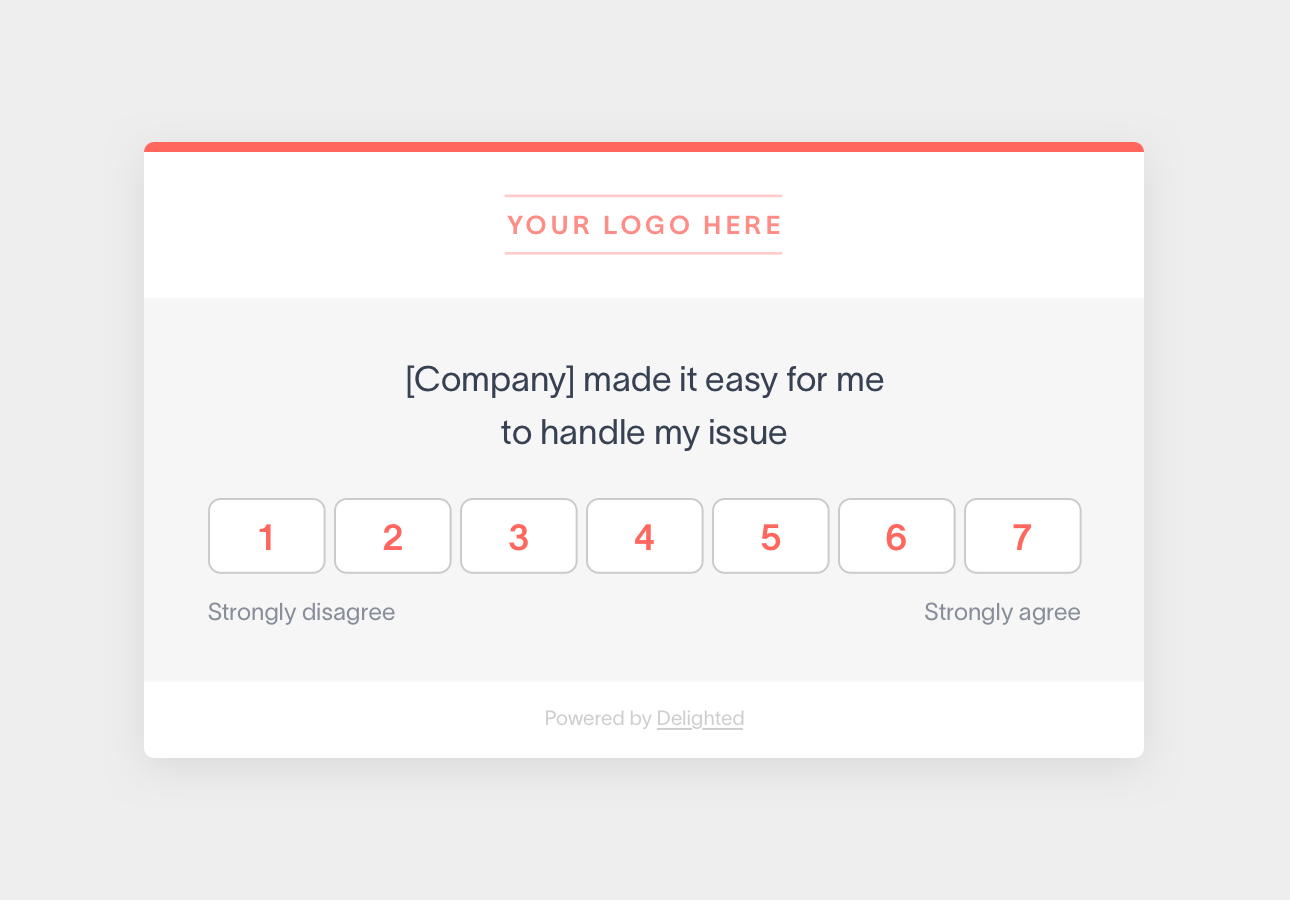
Customer insights
Customer insights are hypotheses made from interpreting both quantitative and qualitative customer data and applying context to gain a deeper understanding of how customers think and feel about your company, product, or service.
In order to improve customer experiences, you need to know what to improve. What are the specific touchpoints that customers are having issues with? What holds customers back from recommending your product to others?
Customer experience surveys and customer analytics help you collect data on these touchpoints. After deriving insights from this data, the next step is implementing solutions that improve your customer experience.
Improving customer experiences
You’ve learned the core customer experience concepts and the terms related to measuring customer experience. Here are CX terms that focus on taking action on customer experience insights and feedback to make meaningful improvements.
Customer experience design (CXD)
Customer experience design is the designing of products and services based on customer insights to ensure every customer touchpoint delivers on the promises laid out by your company.
It’s worth mentioning that although user experience (UX) is related, it is only a part of customer experience design. Whereas UX pertains mainly to a user’s experience as they navigate your product, CXD encompasses UX as well as everywhere else customers engage with your company.
Customer relationship management (CRM)
Customer Relationship Management is the processes, strategies, and tools that your company uses to oversee, manage, and improve interactions with new and existing customers.
“CRM” is most commonly thought of as a type of software, but customer relationship management (CRM) is more than that. It includes:
- Strategy: The company’s overall approach to handling customer relationships.
- Processes: The ways company employees handle all customer interactions and ensure they’re following the company’s CRM strategy.
- Technologies: The tools used to record customer interactions and analyze them for constant improvement and customer success.
When you combine Customer Experience Management with your CRM strategy, the result is a highly efficient system for incorporating customer feedback into your day-to-day customer interactions to close the loop and better meet the needs of your customers.
Closing the loop
Closing the loop is the process of taking action on customer experience feedback and directly following up with those who provide the feedback.
Here are a few common ways a closed-loop feedback system can benefit you:
- Inform customer experience design decisions: Uncover customer insights from the feedback, leading to decisions on how to design improved customer experiences.
- Fix critical issues that create detractors: Follow up with customers who had a poor experience to improve their perception of your company, and hopefully turn unhappy customers into fans.
- Gain value from promoters: Keep in contact with satisfied customers to maintain a positive relationship and encourage brand advocacy. This is also a great way to source customer testimonials that provide valuable social proof for your marketing efforts.
- Strengthen relationships with passive customers: Customers that fall in the passive category from an NPS survey can be a good source of valuable insight on how to improve your brand. Proactively engage them to learn how to go from a mediocre experience to a stellar one.
Additional customer experience resources
For more information on CX, check out these best practices guides:
- Customer satisfaction survey questions
- Customer experience management programs
- Mastering customer intelligence
- Customer feedback analysis
- Customer experience maturity
With knowledge of CX, customer experience strategies, CX metrics, and more, you’re ready to start collecting customer feedback and acting on the insights.
Ready to get started building your CX program? Explore our survey templates and send surveys in minutes.
